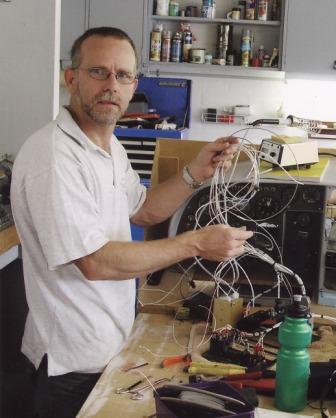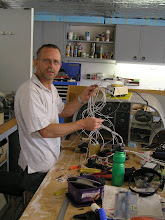When I left off last time I had built the two channels for the augmentors and lined them with fibrefrax.

Next I covered the fubrefrax with 2 layers of BID using high temp vinyl ester resin. This stuff stinks like crazy, need plenty of ventilation. 
A little post cure to harden things up.

Now it's time to make sills to attach the cap to. I reused the chunk of foam I cut out of this slot and dropped the top surface a little to allow for the thickness of the cap and rounded the edges for a generous fillet. Packing tape allows easy release and ensures a smooth finish when I cut the foam out later.

FAILURE number ??? (too many to remember them all). You see I have been working almost exclusively with Epoxies but for this fillet I was using VE. I mixed VE with flox to make the 900mm long ledges but as they started to harden they started to shrink. Over the 900mm length a 2.5% shrink amounts to a shortening of the top edges by 25 to 30mm. This was enough to start bending the existing channel up out of it's bedding. The cracking noises as energy was pulling the edges away was quite alarming. S#!+ what do I do now....? I pulled out a grinder and cut out the semi-hard resin, I'll have to come up with a recovery plan. Had I known about this earlier I would have done 2" segments 2" apart, let them set then come back and do the other set of 2" segments. Oh well experimental category is for education.

Well I mixed up a batch of resin and bonded the channel back into place. Changed the plans to have the cap extend past and over the channel edges rather than inside it. This is a sheet of BID & VE I made up on a piece of glass. Nice and flat.

This is a shot up the augmentor with the cap bonded into place. I will come back later and fillet the joints once the aircraft is back on it's wheels.

This shows the transition from augmentor to the exit ramps.

Here I'm trying out my vacuum bagging rig. I'm making a wide sheet of Glass and will later cut it into strips and stack them together to make a sturdy strip to harden the front edge of the augmentors and for a place to attach piano hinge for the cowl.

Strips bonded together.

and bonded to the front lip. You wouldn't believe how tough this is now.

I've fared back from the lip and have started to attach the hinge. I will cover the whole lot later with a final couple of layers of glass to protect it from stone damage.

2 layers if glass and peelply



A little post cure to harden things up.

Now it's time to make sills to attach the cap to. I reused the chunk of foam I cut out of this slot and dropped the top surface a little to allow for the thickness of the cap and rounded the edges for a generous fillet. Packing tape allows easy release and ensures a smooth finish when I cut the foam out later.

FAILURE number ??? (too many to remember them all). You see I have been working almost exclusively with Epoxies but for this fillet I was using VE. I mixed VE with flox to make the 900mm long ledges but as they started to harden they started to shrink. Over the 900mm length a 2.5% shrink amounts to a shortening of the top edges by 25 to 30mm. This was enough to start bending the existing channel up out of it's bedding. The cracking noises as energy was pulling the edges away was quite alarming. S#!+ what do I do now....? I pulled out a grinder and cut out the semi-hard resin, I'll have to come up with a recovery plan. Had I known about this earlier I would have done 2" segments 2" apart, let them set then come back and do the other set of 2" segments. Oh well experimental category is for education.

Well I mixed up a batch of resin and bonded the channel back into place. Changed the plans to have the cap extend past and over the channel edges rather than inside it. This is a sheet of BID & VE I made up on a piece of glass. Nice and flat.

This is a shot up the augmentor with the cap bonded into place. I will come back later and fillet the joints once the aircraft is back on it's wheels.

This shows the transition from augmentor to the exit ramps.

Here I'm trying out my vacuum bagging rig. I'm making a wide sheet of Glass and will later cut it into strips and stack them together to make a sturdy strip to harden the front edge of the augmentors and for a place to attach piano hinge for the cowl.

Strips bonded together.

and bonded to the front lip. You wouldn't believe how tough this is now.

I've fared back from the lip and have started to attach the hinge. I will cover the whole lot later with a final couple of layers of glass to protect it from stone damage.

2 layers if glass and peelply

Trimmed, sanded and a couple of layers of epoxy primer. I will come back much later and do a little bit of filling and sanding but for now I just want to flip her back the right way up so I can start the final push for the finish line.




1 comment:
Hi Paul.....very impressive build so far. The augmentors and flaps look great. Keep the pictures coming.
Post a Comment